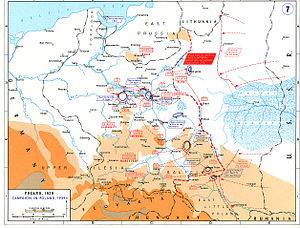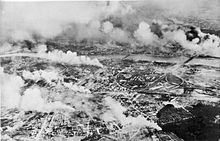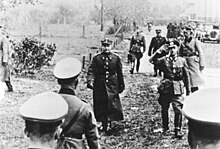Battle of Warsaw (1939)

Situation development after September 14th. The associations enclosed in Warsaw can be seen on the map
| date | September 8-28, 1939 |
|---|---|
| place | near Warsaw , Poland |
| output | German victory |
| consequences | Occupation of Warsaw |
| Parties to the conflict | |
|---|---|
| Commander | |
|
|
|
| Troop strength | |
| 175,000 | 124,000 |
| losses | |
|
1,500 dead, 5,000 wounded |
6,000 dead, 16,000 wounded and 100,000 prisoners |
Gdansk - Westerplatte - Tucheler Heide - Krojanten - Mlawa - Radom - Wizna - Bzura - Brześć - Lemberg - Rawa Ruska - Lublin - Kampinos Heath - Warsaw - Szack - Modlin - Hel Peninsula - Kock
During the attack on Poland in the Battle of Warsaw , the Polish Army Warsaw ( Armia Warszawa ), trapped in the Polish capital Warsaw , fought against units of the German Wehrmacht . The fighting began with large-scale air strikes on military facilities and infrastructure targets in the greater area of the Polish capital, Warsaw, from the first day of the war, September 1, 1939.
prehistory
Since the first day of the war, the German air force has attacked targets in the greater Warsaw area with varying degrees of intensity. The first of 54 aircraft existing interceptors - Brigade could shoot down 43 enemy planes in the first days of the bombing, but was even decimated and taken off on September 6 to the east. The day before eleven were Flak - batteries have been withdrawn from the city. The bombardment peaked on September 10, “Bloody Sunday”, when 17 air strikes took place.
On September 3, the Polish Commander-in-Chief Marshal Edward Rydz-Śmigły ordered the formation of a High Command for the Defense of Warsaw and appointed Divisional General Walerian Czuma , the previous head of the border troops , as its commander. The mayor Stefan Starzyński , appointed civil commissioner by Czuma , ordered the formation of a civil guard to replace the police and fire brigade , who, like most of the men of military age, were evacuated. In daily radio speeches he urged the population to take part in the construction of barricades and anti-tank traps . The troops available for defense, initially only four battalions , were gradually supplemented by withdrawing units of the army and recruiting.
The commander-in-chief of the attacking 8th Army was General of the Infantry Johannes Blaskowitz . To the east of the city, the 1st Army Corps under Lieutenant General Walter Petzel had advanced as part of the 3rd Army of General of the Artillery Georg von Küchler . On the Polish side, General Juliusz Rómmel led the Warsaw Army, which was set up on September 8, defending the area around Warsaw and the Modlin Fortress . Subordinate to him was General Czuma as the commander of the defense of Warsaw, who entrusted Juliusz Zulauf with the defense in the east of the city and Marian Porwit with that in the west.
course
The ground fighting began on September 8, 1939 after German tank units of the 4th Panzer Division with parts of the 31st Infantry Division under the leadership of General Hossbach reached the south-western suburbs of Warsaw. A quick capture of Warsaw by German troops failed, however, after parts of the attacking troops were withdrawn as a result of the Battle of the Bzura, west of Warsaw , which began on 9 September . On September 15, Warsaw was also surrounded by German troops from the east. During the street fighting in the eastern district of Praga , the retired Colonel General Werner von Fritsch , who had accompanied his regiment as chief , fell. The complete military encirclement of Warsaw on September 15th had created a large pocket. This stretched starting in Modlin north of Warsaw along the east bank of the Vistula to the urban area of Warsaw. To the west there was still a loose connection with the Polish army units located in the Kutno area . This connecting line led through the impassable forest area of the Kampinosheide northwest of Warsaw. After the end of the Battle of the Bzura, the remnants of the encircled troops fought their way through the Kampinosheide area ( Battle of the Kampinos Heide ) to Warsaw and brought the number of defenders to 120,000 soldiers.
After the end of the fighting in the Kampinosheide, the Warsaw / Modliner cauldron was completely closed from the west. On September 22nd, the connection between Warsaw and Modlin was finally interrupted by a German advance from the east to the Vistula. There were now two besieged cauldrons left. The pocket of Warsaw with around 120,000 soldiers defending it and the pocket of Modlin with around 60,000 Polish defenders. For strategic and political reasons, the German armed forces now concentrated their forces on conquering the Polish capital, Warsaw.
In preparation for the final attack, the Polish defense lines in the suburbs of Warsaw in particular were shelled for days by German artillery, including railway guns and siege mortars; at the same time the tactical bombardment by two German air fleets was continued. On September 24th, all German troops involved in the siege were placed under Blaskowitz's command. The following day the Germans carried out a major attack with a total of nine divisions , which was repulsed. At the same time, the German air force flew a destruction attack on the city area; In over 1,700 missions, the bombers dropped 560 tons of high explosive and 72 tons of incendiary bombs. On September 26, the former commander in chief of the Poznan Army, Tadeusz Kutrzeba, started negotiations to surrender the city. A ceasefire came into effect on September 27 at 12:00 p.m. Several Polish units refused to stop the fire and had to be requested personally by Rómmel and Czuma. On September 29, Warsaw's defenders hid or destroyed their weapons. The following day, around 100,000 Polish soldiers left the city of Warsaw and were taken prisoner by Germany . Five days after the unconditional surrender of Warsaw, the German Wehrmacht occupied the city center of Warsaw, which had been evacuated by Polish troops, without a fight.
consequences
With the surrender of Warsaw and the Modlin Fortress ( Battle of Modlin ), the attack on Poland was practically over. Isolated groups of the Polish army such as the “Independent Operations Group Polesia ” were defeated by October 6th (→ Battle of Kock ).
The losses of the siege of Warsaw amounted to 6,000 dead and 16,000 wounded soldiers on the Polish side, about 100,000 were taken prisoner. 25,800 civilians were killed and over 50,000 injured. The German losses are estimated at 1,500 dead and 5,000 wounded. About 12 percent of Warsaw's buildings were destroyed in the fighting. The government district and the Warsaw suburbs along the front line were particularly hard hit by the destruction.
Some of the hidden weapons were later used in the Warsaw Uprising .
literature
- Władysław Bartoszewski : 1859 Dnii Warszawy. Wydawnictwo Znak, Krakow 1974.
- Julien Bryan : victories. Doubleday, New York NY 1940.
- Norbert Konwinski: The Mayor. Saga of Stefan Starzynski. Diversified Enterprises, Claremont NH 1978, ISBN 0-9601790-0-3 .
- Janusz Piekałkiewicz : Polish campaign. Hitler and Stalin smash the Polish Republic. Bechtermünz, Augsburg 1998, ISBN 3-86047-907-5 .




